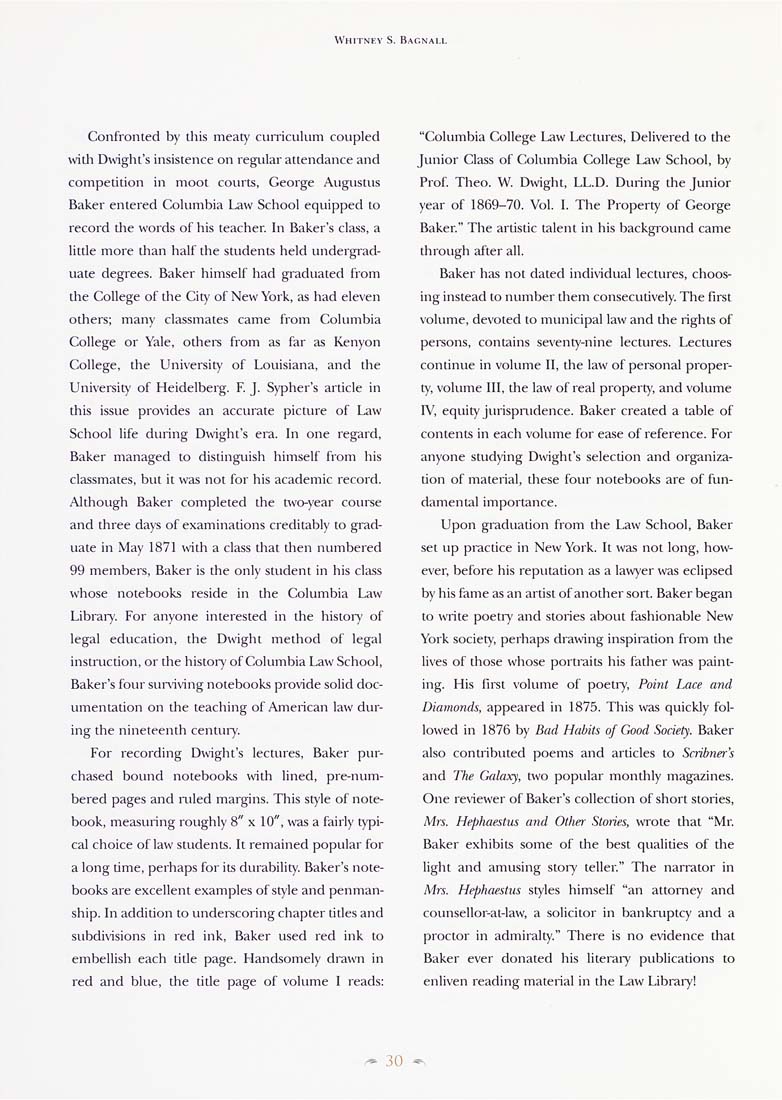Columbia Library columns (v.44(1995))
(New York : Friends of the Columbia Libraries. )
|
||
|
|
|
|
| v.44,no.1(1995:Winter): Page 30 |

Whitney S. Bagnall Confronted by this meaty curriculum coupled wiUi Dv\'ight's insistence on regular attendance and competition in moot courts, George Augustus Baker entered Columbia Law School equipped to record the words of his teacher. In Baker's class, a litde more than half the students held undergrad¬ uate degrees. Baker himself had graduated from the College of die City of New York, as had eleven others; many classmates came from Columbia College or Yale, others from as far as Keiiyon College, the University of Louisiana, and the University of Heidelberg, F. J. Sypher's article in this issue provides an accurate picture of Law School life during Dwight's era. In one regard, Baker managed to distinguish himself from his classmates, but it was not for his academic record. Although Baker completed the two-year course and three days of examinations creditably to grad¬ uate in May 1871 with a class that then numbered 99 members. Baker is the only student in his class whose notebooks reside in the Columbia Law Librar)'. For anyone interested in the histor)' of legal education, the Dwight method of legal instruction, or the histor)' of Columbia Law School, Baker's four surviving notebooks provide solid doc¬ umentation on the teaching of American law dur¬ ing the nineteenth century. For recording Dwight's lectures, Baker pur¬ chased bound notebooks with lined, pre-num- bered pages and ruled margins. This st)'le of note¬ book, measuring roughly 8" x 10", was a fairly typi¬ cal choice of law students. It remained popular for a long time, perhaps for its durability. Baker's note¬ books are excellent examples of style and penman¬ ship. In addition to underscoring chapter tides and subdivisions in red ink, Baker used red ink lo embellish each tide page. Handsomely drawn in red and blue, the tide page of volume 1 reads: "Columbia College Law Lectures, Delivered to the Junior Class of Columbia College Law School, by Prof Theo. W. Dwight. LL.D. During the Junior year of 1869-70. Vol, I. The Property of George Baker." The artistic talent in his background came through after all. Baker has not dated individual lectures, choos¬ ing instead to number them consecutively. The first volume, devoted to municipal law and the rights of persons, contains seventy-nine lectures. Lectures continue in volume II, the law of personal proper¬ ty, volume III, the law of real propert)', and volume rV, equityjiuisprudence. Baker created a table of contents in each volume for ease of reference. For anyone studying Dwight's selection and organiza¬ tion of material, tiiese four notebooks are of fun¬ damental importance. Upon graduation from the Law School, Baker .set up practice in New York. It was not long, how¬ ever, before his reputation as a lav\')'er was eclipsed by his fame as an artist of another sort. Baker began to write poetry and stories about fashionable New York society, perhaps drawing inspiration from the lives of those whose portraits his father was paint¬ ing. His first volume of poetry. Point Lace and Diamonds, appeared in 1875. This was quickly fol¬ lowed in 1876 by Bad Habits of Good Society. Baker also contributed poems and articles to Scribner's and The Galaxy, two popular monthly magazines. One reviewer of Baker's collection of short stories, Mrs. Hephaestus and Other Stories, wrote that "Mr Baker exhibits some of the best qualities of the light and amusing stor)' teller," The narrator in Mrs. Hephaestus styles himself "an attorney and counsellor-at-law, a solicitor in bankruptcy and a proctor in admiralty." There is no evidence that Baker ever donated his literary publications to enliven reading material in the Law Library! 30 |
| v.44,no.1(1995:Winter): Page 30 |







